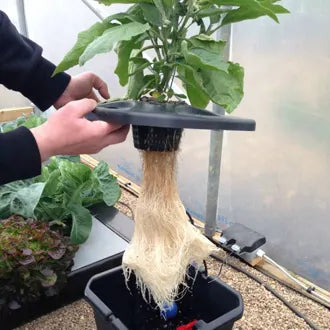Deep Water Culture / Bubbler Buckets

There are several methods of growing hydroponically. The main ones are: Flood & Drain (aka Ebb and Flow / Flood), NFT (Nutrient Film Technology) and finally DWC (Deep Water Culture, or Bubbler Buckets).
The Flood and Drain method is one of the oldest and most traditional of hydroponics grow methods. However, it uses a large amount of grow media, and requires the use of a large reservoir. NFT uses less media, and keeps grow-heights slightly lower. However, the plants usually need lots of additional support. As with many things, there are advantage/disadvantages and compromises to be had with the different ways of growing a plant.
The Deep Water Culture (DWC), or "Bubble-bucket" method offers a different way again of hydroponic growing. It is hugely popular and only ever getting more so! One of its main advantages is that it requires very little grow medium - only a small net-pot filled with clay pebbles is needed for each plant. The roots then grow down into the larger, well-aerated reservoir of nutrient solution below. As well as this, DWC boasts fast plant growth and a reduced need for bulky equipment. To top it off, it's inexpensive and simple to set up. See here DWC Systems and Air Pumps & Airstones.
About DWC
R-DWC is a special type of DWC setup where several bubblers are connected together and a pump circulates the nutrient solution around them. This increases the oxygenation still further, and keeps the solution well mixed and even between the pots. R-DWC basically pushes things a step further than standard DWC. High oxygenation makes it difficult for root diseases to survive; however, it's still not a bad idea to add in some Silver Bullet Roots just to make sure.
Excellent success can easily be had with such systems as long as a few good pieces of advice are followed:
1) When rooted cuttings are first transplanted into the system, the surrounding clay pebbles must be watered (usually by hand) once or twice daily until sufficient roots grow down into the nutrient solution below and the plant can reach water for itself.
2) There must be an airstone in the bottom of the reservoir that is fed by a pump with sufficient airflow to keep the solution well oxygenated and mixed. We would generally recommend one litre of air for every four litres of water, per minute. This works out at about about 5 litres /minute (or 300 litres of air per hour) for the average size (15-20 litre) DWC bucket. Some growers go much higher than this with a "more must be better" line of thinking. However, we believe there is a limit to this. Too much air flow will create an absolute maelstrom inside the reservoir with the roots being thrown around continuously, which could lead to root damage. Stay on the sensible side of things and everything will be just fine.

3) The air pump must be left on at all times. If the pump breaks, it needs to be replaced quickly because the dissolved oxygen in the solution will get used up in no time. The plant roots need oxygen to be healthy. It's a good idea to have a spare pump to hand just in case the worst should ever happen. Also make sure you are using a check valve (non-return valve) in the air line to prevent water back-siphoning from the bucket into the pump which will almost certainly ruin it. For the same reason, always place the air pump on a surface which is higher than the top of the highest bucket.

4) The reservoir needs to be topped up and kept within a few centimetres of the bottom of the net pot. This is key. If the reservoir gets too low, there won't be enough roots submerged in the nutrient solution to supply the plant with adequate water. We have known growers who have got caught out during peak flowering. Their plants had literally started getting through half a reservoir of solution a day. By the time they checked after 2 days, the reservoir was empty and the plants had already suffered.
5) Keep an eye on the temperature of the reservoir. The motors in poor quality air pumps (or those that have been covered over to keep the sound down) will get hot. This heats the air being fed to the bubble buckets which in turn heats up the nutrient solution. Once the temp of the water rises over about 23C, there is an ever-increasing risk of diseases like pythium. Plus, the warmer that water gets, the less oxygen it can hold.
If you stick to those guidelines you'll have a nice, inexpensive grow system that will really deliver the goods. And won't create huge quantites of waste after each grow!

